Where is research on AI conducted in Poland?
The report “AI researchers and their publications” looks at data concerning publications on artificial intelligence, broken down by disciplines, research centres, or the quality of the journal in which the scientific paper was published.
- The first part of the report presents the results of searches of the Polish Scientific Bibliography (PSB) contents for publications by researchers representing all disciplines of science using a list of keywords. More information can be accessed here.
- In this part of the report, the analysis is narrowed down to the group of researchers representing computer and information sciences falling under natural sciences, and information and communication technology. More information can be accessed here.
- The third part of the report concerns statistics based on the PSB searches for articles on AI published in high-profile IT journals. More information can be accessed here.
- The fourth part of the report presents the relevant maps, a ranking of research centres and their publication strategies. More information can be accessed here.
FULL TEXT OF THE REPORT in pdf format can be accessed HERE(please note: due to the mode of data presentation, this version is slightly different than the Internet version, where the last two chapters have been merged into one).
Map of AI research centres
Map of research centres with the highest number of computer science researchers who published scientific papers on AI in the years 2013-2018
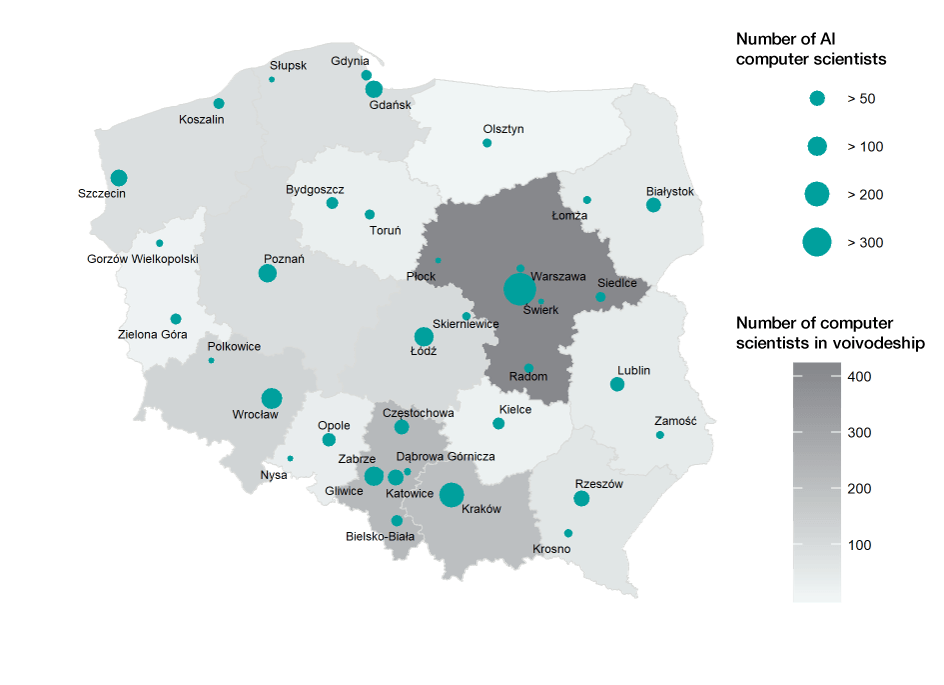
Data for particular regions
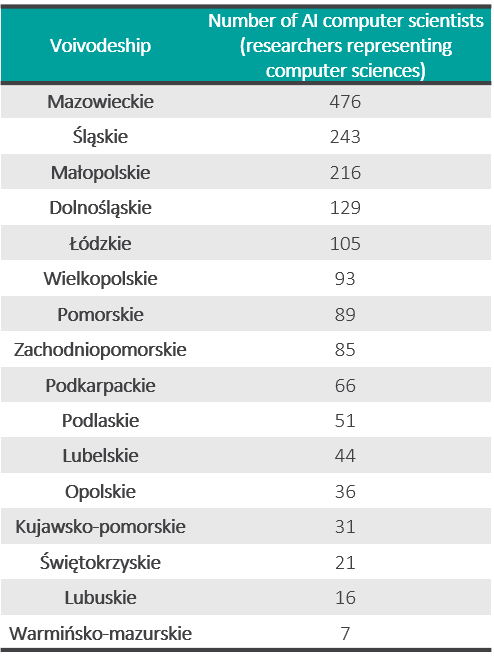
Map of research centres with the highest number of researchers who published papers on AI in high-profile journals in the years 2013-2018
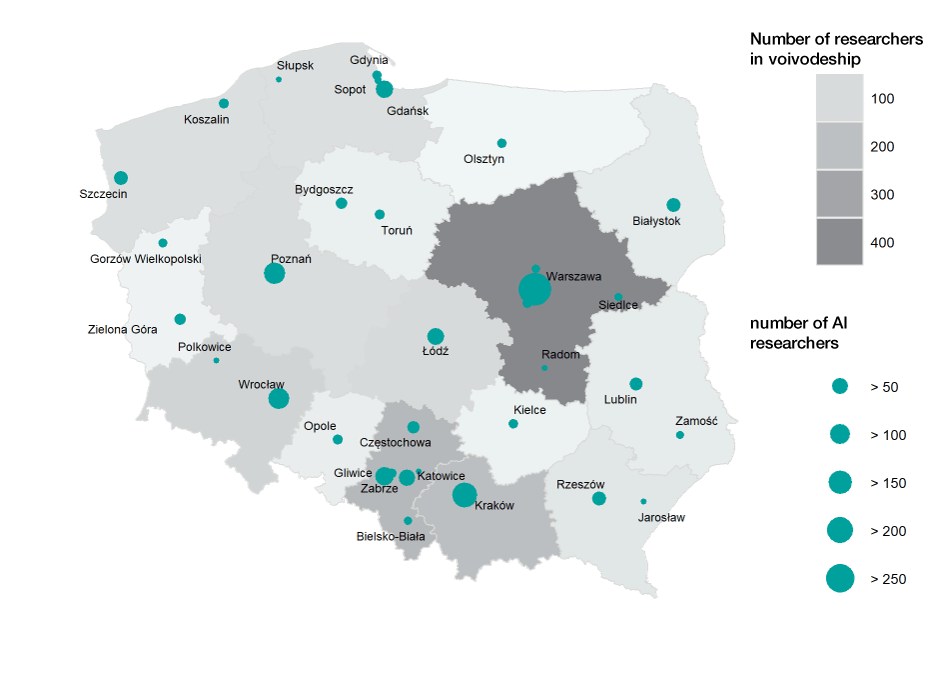
Source: OPI PIB own analysis based on the PSB, as of 07.05.2019.
Data for regions
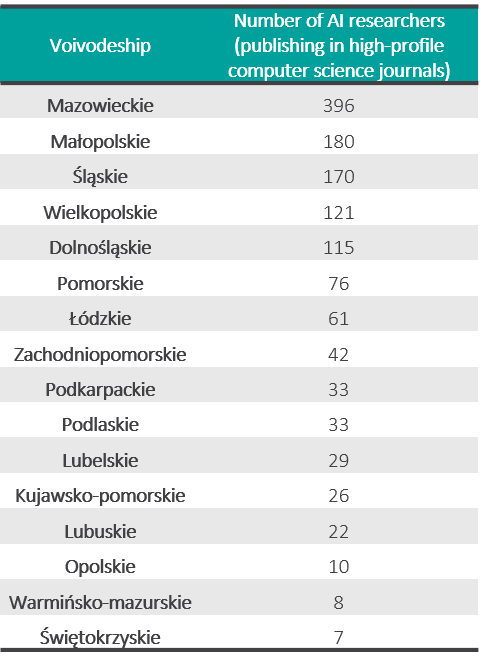
Map of the research centres with the highest number of researchers from all scientific disciplines who published their AI papers in the years 2013-2018
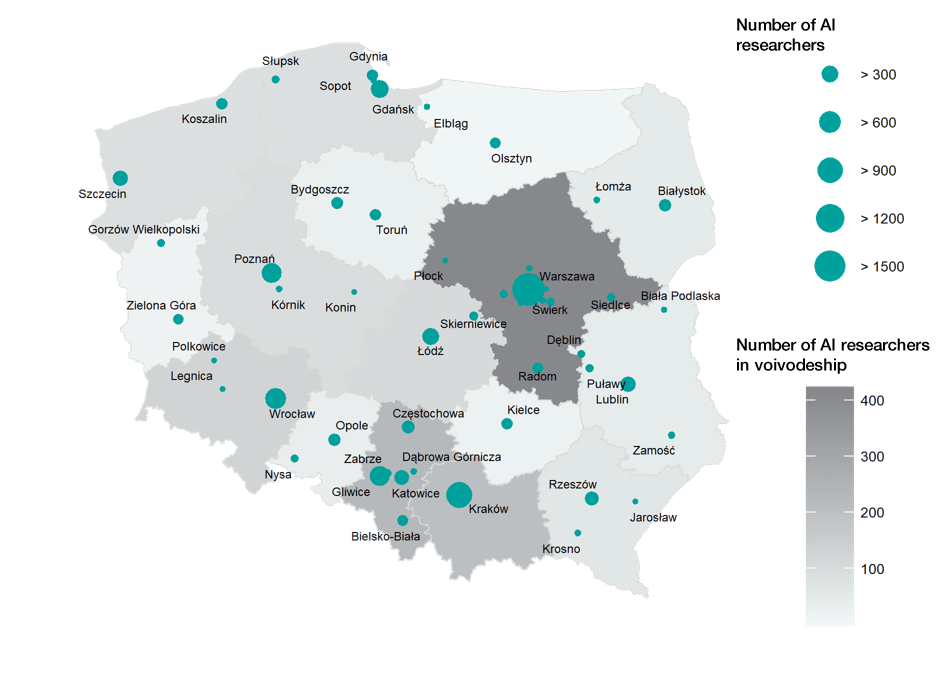
Source: OPI PIB own analysis based on the PSB, as of 07.05.2019.
Data presentation by regions
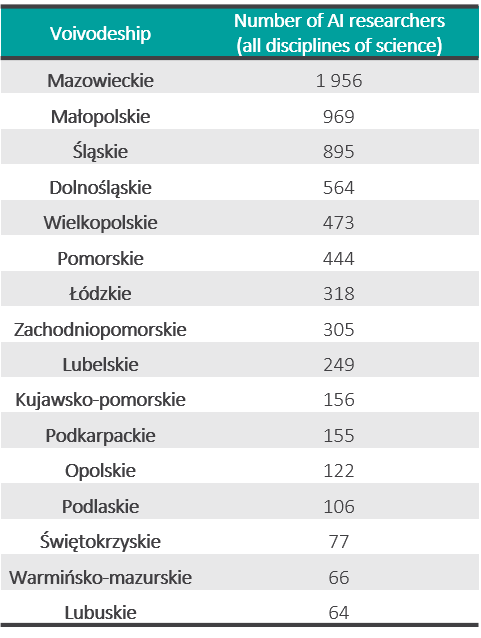
Rankings of scientific and research institutions
The following rankings present data on of scientific institutions employing the largest number of researchers in computer science disciplines (computer and information sciences within natural sciences, information and communication technology) in Poland’s regions (voivodships) and seven macro-regions. The table also contains information on the number of researchers from a given institution who publish in prestigious AI journals and on the total number of AI researchers across all disciplines. The table was compiled using data on publications registered in the PSB: both those collected on the basis of a list of keywords and those published in high-profile AI journals as presented on the list from the Guide2Research website (see methodological appendices).
Ranking of scientific institutions with the highest number of computer science researchers who published scientific papers on AI in the years 2013-2018, by voivodeship: the southern macro-region.

Source: OPI PIB own analysis based on the PSB, as of 07.05.2019.
Ranking of scientific institutions with the highest number of computer science researchers who published scientific papers on AI in the years 2013-2018, by voivodeship: the Mazovia macro-region (Mazowieckie voivodship)
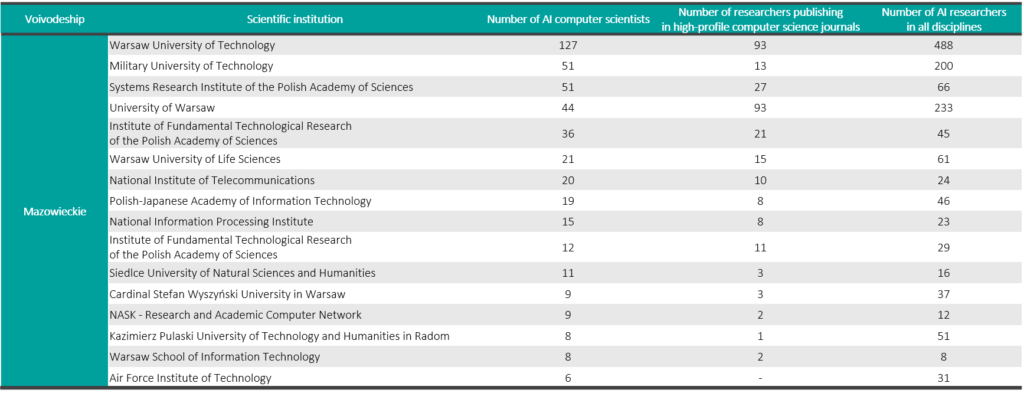
Source: OPI PIB own analysis based on the PSB, as of 07.05.2019.
Ranking of research centres with the highest number of computer science researchers who published scientific papers on AI in the years 2013-2018, by voivodeships: the northern, eastern and central macro-regions
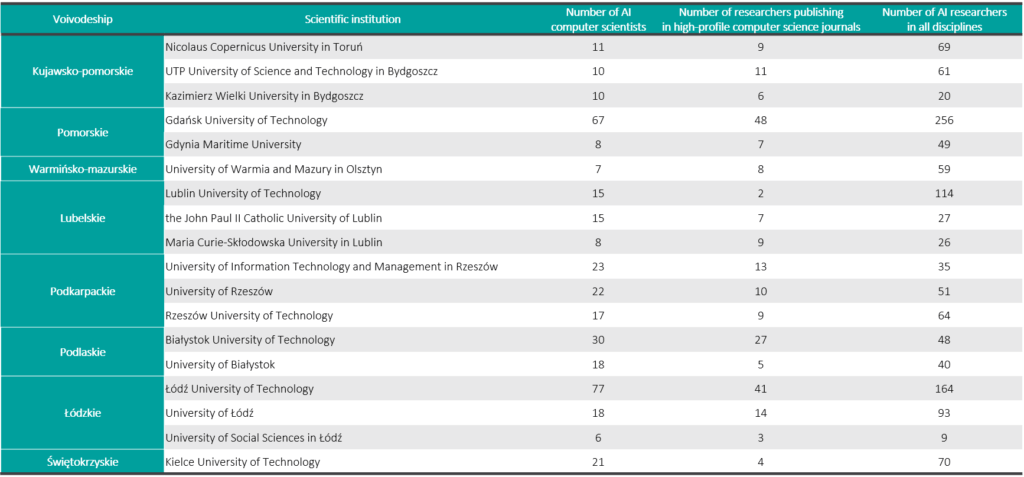
Source: OPI PIB own analysis based on the PSB, as of 07.05.2019.
Ranking of research centres with the highest number of computer science researchers who published scientific papers on AI in the years 2013-2018, by voivodeships: the north-western and south-western macro-regions.

Source: OPI PIB own analysis based on the PSB, as of 07.05.2019.
Publication strategies of AI research centres
Statistics on researchers of AI and their publications based on a list of high-profile IT journals on AI and a list of keywords identifying AI publications.
Number of publications in high-profile journals and number of other publications concerning AI by researchers employed in selected scientific institutions, from the years 2013-2018
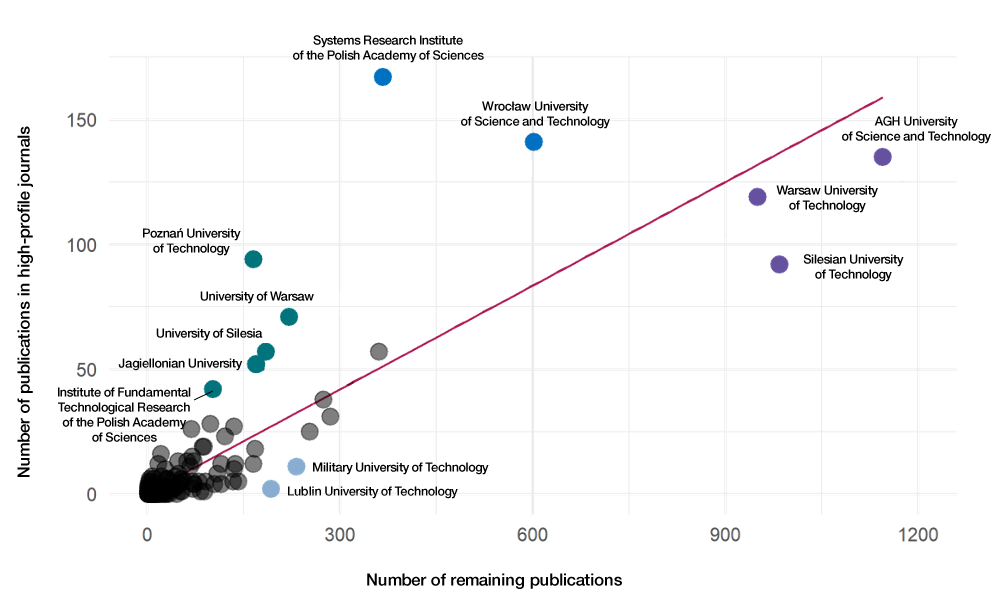
Source: OPI PIB data analysis based on output from the PSB system, as of 7 May 2019.
The analysis of the ratio of the number of publications in high-profile AI journals to the number of other publications allows to identify groups of the most prolific scientific institutions with specific publication strategies.
The research centres which publish mostly in high-profile AI journals are Systems Research Institute of the Polish Academy of Sciences and Wrocław University of Science and Technology (marked in blue). The total number of publications of these two universities is also significant but it is smaller than in the case of three large public universities: AGH University of Science and Technology, Warsaw University of Technology and Silesian University of Technology (marked in purple).
Other institutions that stand out are: Poznań University of Technology, University of Warsaw, University of Silesia, Jagiellonian University, and Institute of Fundamental Technological Research of the Polish Academy of Sciences (marked in green). Their employees published a significant number of articles in top journals on AI, while the number of publications on other subjects is smaller than in the case of the groups of institutions mentioned before.
The Military University of Technology and Lublin University of Technology (light blue) are universities with a relatively high number of publications in journals which are not included in the list of top journals.
Number of publications in top journals and number of remaining publications on AI by researchers employed in selected research centres and representing computer sciences in the years 2013-2018
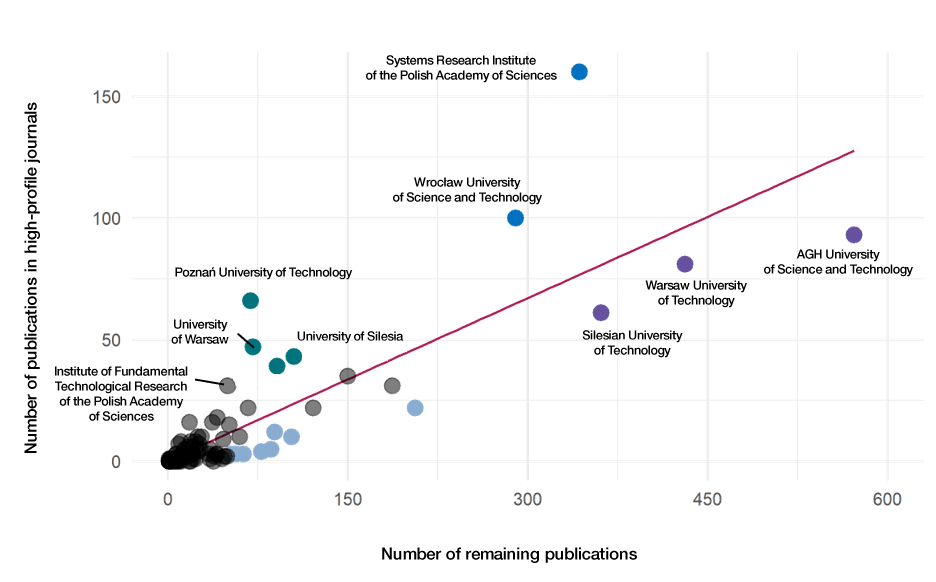
Source: OPI PIB own analysis based on the PSB, as of 07.05.2019.
The analysis of the ratio of the number of publications in top AI journals to the number of other publications can also be narrowed down to computer science disciplines.
The research centres which publish mostly in top AI journals are Systems Research Institute of the Polish Academy of Sciences and Wrocław University of Technology (marked in blue). Their overall number of publications is also prominent, but lower than in the case of three large public universities: AGH University of Science and Technology, Warsaw University of Technology, and Silesian University of Technology (marked in purple).
Other institutions that stand out in terms of the number of AI publications are Poznań University of Technology, University of Warsaw, Silesian University of Technology, Jagiellonian University, and Institute of Fundamental Technological Research of the Polish Academy of Sciences (marked in green). Their employees published a significant number of articles in top AI journals, while the number of other types of publications is rather limited compared to the groups of institutions mentioned before.
The universities with a relatively high number of publications in journals which are not included in the list of top journals (marked in light blue) are: Łódź University of Technology, Polish-Japanese Academy of Information Technology, Kielce University of Technology, Military University of Technology, Maritime University of Szczecin, Siedlce University of Natural Sciences and Humanities, and University of Łódź.
Methodological appendices
Appendix 1
Method of selecting keywords for the analysis of data from the Polish Scientific Bibliography
The selection of AI publications and researchers was made using machine methods (automatic search of databases), based on a list of keywords. It was assumed that this would allow to identify research papers on AI methods, applications and social aspects of the development of new technologies, presenting either a narrow (technical) or a broad picture of artificial intelligence.
The list of keywords was developed in a four-step-process. First, a broad set of keywords was compiled on the basis of the literature on the subject. Next, it was verified by experts: practitioners and researchers specialising in the area of AI (six people in total). At this stage, we eliminated the words which wrongly identify AI papers or are not unique to AI publications. The experts also had the opportunity to present their own keyword proposal. The list developed in this way included 294 terms in English.
At the next stage, the list of words in English was translated into Polish. The translated list included all possible translation options, which means that there were eventually more keywords in Polish than in English. The applied search technology enabled us to identify papers on the basis of singular, plural and declined words from the list.
At the final stage, after searching for publications in the PSB, a sample of titles and abstracts was selected in order to finally verify the effectiveness of the selected keywords in the identification of publications on AI. At this stage, a total of 29 phrases were eliminated from the set as they were too ambiguous to precisely identify papers concerning AI. Moreover, four phrases (emotion recognition, expression recognition, object recognition, pattern recognition) were removed from the list of keywords only for certain disciplines of science (e.g. psychology, linguistics, medical sciences) where the phrases are used in a different context. The verification of the list of keywords therefore allowed for the removal of excessively broad concepts that are not an exclusive distinguishing feature of artificial intelligence (e.g. clustering, casualty, Python, smart devices). Selected terms, however, are so broad in their meaning that they also identify narrower phrases (e.g. the term “convolutional neural network” identifies “neural network”).
Statistics prepared with the use of such a list of keywords are a good approximation of real-world values. The developed list can be extended in the future to include new keywords and other foreign languages. It can also be consulted with a different pool of experts.
Key sources for the identification of the keyword lists:
-
Association
for the Advancement of Artificial Intelligence,
AITopics
https://aitopics.org/search -
China
Institute for Science and Technology Policy at Tsinghua University
(2018) China AI
Development
http://www.sppm.tsinghua.edu.cn/eWebEditor/UploadFile/Executive_susmmary_China_AI_Report_2018.pdf -
Corea F.
(2018) AI Knowledge Map: How To Classify AI
Technologies
https://www.forbes.com/sites/cognitiveworld/2018/08/22/ai-knowledge-map-how-to-classify-ai-technologies/#35a4feaf7773 -
Glossary of
artificial
intelligence
https://en.wikipedia.org/wiki/Glossary_of_artificial_intelligence -
Goodfellow I.
et. al. (2019) Deep
Learning
https://github.com/janishar/mit-deep-learning-book-pdf/blob/master/complete-book-pdf/deeplearningbook.pdf.
Appendix 2
Method of selecting top computer and information science journals on AI to analyse data from the Polish Scientific Bibliography
The set of IA publications in computer and information science journals to be analysed was determined on the basis of a list of Top Journals for Computer Science and Electronics published by Guide2Research.com. The webpage gathers data on research and international scientific conferences. In the tab “Top 600 Journals”, a list of international journals with impact factor is presented, divided by thematic areas under computer and information sciences.
For the purposes of the analysis, the following lists were used:
- 111 journals from the area of machine learning, data mining and artificial intelligence,
- 57 journals from the area of image processing and computer vision,
- 28 journals from the area of human computer interaction.
The analysis takes into account all journals from the above lists in which scientists reporting their research achievements to the Polish Scientific Bibliography system published their articles. It should be noted that those journals are included in the list of ranked journals of the Polish Ministry of Science and Higher Education in the so-called A list.
Source for the list of top computer and information science journals on AI:
Please send any questions regarding this study to: labstat@opi.org.pl